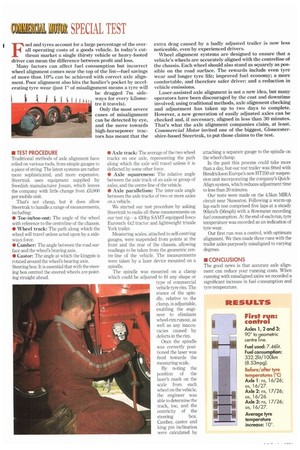• TEST PROCEDURE Traditional methods of axle alignment have relied
Page 28

Page 29

If you've noticed an error in this article please click here to report it so we can fix it.
on various tools, from simple gauges to a piece of string. The latest systems are rather more sophisticated, and more expensive. Steertrak uses equipment supplied by Swedish manufacturer Josam, which leaves the company with little change from £6,000 per mobile unit.
That's not cheap, but it does allow Steertrak to handle a range of measurements, including:
• Toe-in/toe-out: The angle of the wheel with reference to the centreline of the chassis.
• Wheel track: The path along which the wheel will travel unless acted upon by a sideways force.
• Camber: The angle between the road surface and the wheel's bearing axis.
• Castor: The angle at which the kingpin is rotated around the wheel's bearing axis. Steering box: It is essential that with the steering box centred the steered wheels are pointing straight ahead. • Axle track: The average of the two wheel tracks on one axle, representing the path along which the axle will travel unless it is deflected by some other force.
• Axle squareness: The relative angle between the axle track of an axle or group of axles, and the centre-line of the vehicle.
• Axle parallelism: The inter-axle angle between the axle tracks of two or more axles on a vehicle.
We started our test procedure by asking Steertrak to make all these measurements on our test rig—a 420hp SAMT-equipped Iveco Eurotech 4x2 tractor and lightweight triaxle York trailer.
Measuring scales, attached to self-centring gauges, were suspended from points at the front and the rear of the chassis, allowing readings to be taken from the geometric centre-line of the vehicle. The measurements were taken by a laser device mounted on a spindle.
The spindle was mounted on a clamp which could be adjusted to fit any shape or type of commercial vehicle tyre rim. The stance of the spindle, relative to the clamp, is adjustable, enabling the engineer to eliminate wheel-rim runout, as well as any inaccuracies caused by defects in the rim.
Once the spindle was correctly positioned the laser was fired towards the measuring scale.
By noting the position of the laser's mark on the scale from each wheel on the vehicle, the engineer was able to determine the 'Tack, toe, and the centricity of the steering box. Camber, castor and king pin inclination were calculated by attaching a separate gauge to the spindle on the wheel clamp.
In the past this process could take more than a day, but our test trailer was fitted with Hendrickson Europe's new HT250 air suspension unit incorporating the company's QuickAlign system, which reduces adjustment time to less than 20 minutes.
Our tests were made on the 4.51an MIRA circuit near Nuneaton. Following a warm-up lap each test comprised five laps at a steady 90Icm/h (56mph) with a flowmeter recording fuel consumption. At the end of each run, tyre temperature was recorded as an indication of tyre wear.
Our first run was a control, with optimum alignment. We then made three runs with the trailer axles purposely misaligned to varying degrees.
• CONCLUSIONS The good news is that accurate axle alignment can reduce your running costs. When running with misaligned axles we recorded a significant increase in fuel consumption and tyre temperature. Tests with the three trailer axles misaligned against each other proved the mast damaging in terms of fuel consumption and tyre temperature. With just 0.5° of misalignment fuel consumption rose by 3% and tyre temperature by 10°C (from the 26° measured after our control run). At 0.71° of misalignment consumption was up by 10% and tyre temperature by nearly 18°C For our final test the trailer axles were set to crab. This put fuel consumption up by 7%, which we attribute to the increased wind resistance. We recorded little increase in tyre temperature, which came as no surprise as the wheels were all running in the same direction, albeit away from the centre line of the trailer. Assuming a diesel price of 52.8p/lit, we used our figures to calculate potential fuel savings at various annual distances.
100,000km (60,000 miles) 0.71° misalignment: 7.65mpg (36.914/100km); fuel bill, £18,823. Optimum alignment 8.50mpg; fuel bill, 216,941.
Annual saving: £1,882.
129,000km (80,000 miles) 0.71° misalignment: 7.65mpg (36.91it/100km); fuel bill, £25,098. Optimum alignment: 8.50mpg (33.214/100km); fuel bill, £22,588. Annual saving: £2,510.
160,000km (100,000 miles) 0.710 misalignment 7.65mpg (36.914/100km); fuel bill, £31,372. Optimum alignment 8.50mpg (33.2Iitn 00km); fuel bill, 228,235. Annual saving: 23,137.
Put it this way. Judging by our test results, an operator running five tractive units for 160,000km a year over five years might slash his fuel bill by the best part of £80,000 simply by ensuring that all axles were accurately aligned. That would be more than enough to replace one of his vehicles, without taking into account the savings to be made from reduced tyre wear.








































































































